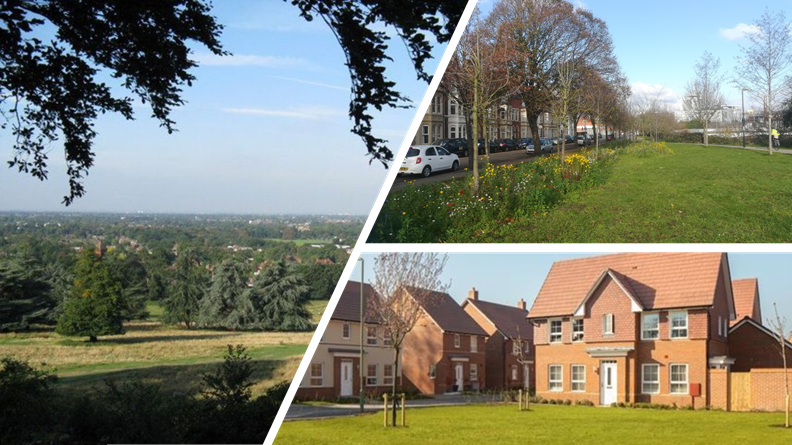Summary
This publication summarises the results of the i-Tree Eco Impact Evaluation study. A PDF version is available to download at the bottom of the page.
General Content
Introduction
The urban forest is defined as all the trees in the urban realm: in public and private spaces, along linear routes and waterways, and in amenity areas. It contributes to green infrastructure and the wider urban ecosystem.
i-Tree Eco surveys aim to capture the state of an urban area’s forest, identify risks to it, estimate an economic valuation of the urban forest, and provide previously unavailable evidence to aid its future management.
This overview presents findings from an evaluation of eight UK based i-Tree Eco surveys conducted four to eight years after completion. The evaluation draws upon the perspectives of those involved in the surveys and evidence of impact. In doing so, this overview reveals the commonly achieved beneficial impacts, as well as the barriers to achieving and identifying impact, so that future projects may seek to increase their reach.
What impacts have been reported?
Table 1 shows that beneficial impacts were common amongst the study areas and across the four categories of impact evaluated.
- Most sites reported major instrumental benefits, for example in Tawe the results were used as evidence in the Swansea Wellbeing Assessment.
- A majority of sites also reported major conceptual beneficial impacts. For example, in Sidmouth the assessment of species abundance led to an awareness of the risks of species-specific diseases such as ash dieback and was noted as key information for future urban forest planning.
- Half of the sites reported major capacity benefits: in Wrexham for example the report helped to retain the post of tree officer despite a shrinking local authority budget.
- For most sites only minor connectivity impacts were reported, such as in Edinburgh where an increase in collaboration between tree and climate change teams was recorded. Similarly, in Glasgow, minor connectivity impact was reported following improved working relationships between national policymakers and researchers.
Table 1. Recorded evidence for beneficial impacts from i-Tree Eco surveys. Major indicates “major beneficial impact”, i.e. direct, well-noted and/or multiple benefits; Minor indicates “minor beneficial impact”, i.e. indirect, less well-noted and/or singular benefits; None reported indicates no published recognition of benefit (note: this does not mean that no benefit occurred).
| Source study | Instrumental
(directly influencing policies and practice, e.g. preservation orders for large trees) |
Capacity
(providing the ability to carry out more in practice, e.g. securing investment for tree officers) |
Conceptual
(knowledge to better inform future work, e.g. data for new infrastructure work) |
Connectivity
(professional links between disparate teams, e.g. between drainage engineers and landscapers) |
| Torbay | Major | Major | Major | Minor |
| Edinburgh | Major | Minor | Major | Minor |
| Glasgow | Major | None reported | Minor | Minor |
| Wrexham | Major | Major | Major | Minor |
| London | Major | None reported | Major | Major |
| Bridgend | Minor | Minor | Major | Major |
| Sidmouth | Major | Major | Major | None reported |
| Tawe | Major | Major | Major | Major |
What are the barriers to identifying and achieving beneficial impacts?
The evaluation was inevitably constrained by the challenges of identifying impact and therefore was likely to have under categorised the full impact of the projects. Some impacts are tangible and easy to identify for the purposes of impact evaluation, including influencing policy or securing funding. Less tangible benefits are more challenging to capture, such as better inter-departmental connectivity. Others, such as an improved understanding of the urban forest amongst local authority staff or i-Tree Eco species composition data guiding future species selection inherently take time to come to fruition.
Evaluation of the i-Tree Eco projects identified a range of barriers to achieving impact, including effective project dissemination, and ensuring the support to do this.
- A lack of clarity of the wider audiences for the report led to poor tailoring of report content and messaging for different groups.
- Lack of resources for dissemination also limited wider engagement and use of the findings.
- Organisational restructuring and staff turnover took up resources to train new staff and caused projects to lose momentum.
What can help increase the beneficial impacts of i-Tree Eco surveys?
The changing climate brings heightened risks to urban forests, from novel pests and diseases to extended periods of extreme weather (such as heat waves).
Considering this and the increasing policy support for urban trees and the benefits they provide to society it is unsurprising that the number of i-Tree Eco surveys completed each year in the UK is increasing.
- The evaluation showed that future projects should seek senior staff buy-in who will champion inter-organisational communication and cross-departmental collaboration.
- Projects should also undertake greater planning at the onset to identify key objectives and audiences, and develop a communication plan.
With these steps, i-Tree Eco projects will be able to better assist local authorities to manage their urban forests and work to ensure sustainable provision of benefits to society.


